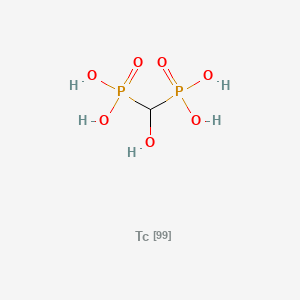



1. Osteoscan
2. Tc-99m Hydroxymethylene Diphosphonate
3. Tc-99m-hdp
4. Tc-99m-hmdp
5. Tc-99m-oxidronate
6. Technetium Hmdp
7. Technetium Osteoscan-hdp
8. Technetium Salt (hydroxymethylene)bis(phosphonic Acid)
9. Technetium Tc 99m Hydroxymethylene Diphosphonate
1. Technescan Hdp
2. Oxidronic Acid 99mtc-complex
3. Technetium Tc-99m Oxidronate
4. 99mtc-hdp
5. Mg4ki49hhj
6. 72945-61-0
7. Technetium 99mtc Oxidronate
8. Technetium Hmdp
9. [hydroxy(phosphono)methyl]phosphonic Acid;technetium-99
10. Phosphonic Acid, (hydroxymethylene)bis-, Technetium-99tc Salt
11. Tc-99m-oxidronate
12. Tc-99m-hmdp
13. Tc-99m-hdp
14. Technetium Osteoscan-hdp
15. Unii-mg4ki49hhj
16. Technescan
17. Tc-99m Hydroxymethylene Diphosphonate
18. Technetium-99mtc-methylene Diphosphonate
19. Technetium Tc 99m Methylene Diphosphonate
20. Technetium Tc 99m Hydroxymethylene Diphosphonate
21. Technetium (99mtc) Oxidronate
22. Technetium Salt (hydroxymethylene)bis(phosphonic Acid)
23. Db09139
24. Technetium Tc-99m Oxidronate Kit
25. Oxidronic Acid 99mtc-complex [mi]
26. Technetium Tc 99m Oxidronate [who-dd]
27. Technetium Tc 99m Oxidronate [usp Impurity]
28. Q22075854
| Molecular Weight | 290.91 g/mol |
|---|---|
| Molecular Formula | CH6O7P2Tc |
| Hydrogen Bond Donor Count | 5 |
| Hydrogen Bond Acceptor Count | 7 |
| Rotatable Bond Count | 2 |
| Exact Mass | 290.865126 g/mol |
| Monoisotopic Mass | 290.865126 g/mol |
| Topological Polar Surface Area | 135 Ų |
| Heavy Atom Count | 11 |
| Formal Charge | 0 |
| Complexity | 174 |
| Isotope Atom Count | 1 |
| Defined Atom Stereocenter Count | 0 |
| Undefined Atom Stereocenter Count | 0 |
| Defined Bond Stereocenter Count | 0 |
| Undefined Bond Stereocenter Count | 0 |
| Covalently Bonded Unit Count | 2 |
Technetium Tc-99m oxidronate is indicated in adult and pediatric patients to be used in skeletal imaging for diagnosis of areas that can present altered osteogenesis. When administered intravenously, it is able to generate a clear image of the bones which allows the physician to diagnose any bone problem. It is important to point out that this drug has to be manipulated only under the service of a nuclear specialist. The approved indications for a bone scan are 1) visualization of tumor metastasis in bone, 2) osteomyelitis, 3) fracture, 4) stress fracture, 5) avascular necrosis, 6) osteoporosis and 7) prosthetic joint evaluation. From all the major indications, the detection of a metastatic disease is the most common because it presents a 95% of sensitivity and lesion detection can be done 6 months earlier than with X-ray studies.
FDA Label
The technetium is generated in a molibdene generator. Technetium Tc-99m presents a reduction of gamma emission after 6 hours and it is considered a quasi-stable molecule. The visualization of bone lesions is possible since there is an altered uptake in areas of abnormal osteogenesis. The principal photon used for detection is the gamma-2 with an energy of 140.5 keV. Its use for bone examination should be performed 2 hours after initial injection with a recommended activity on the range of 370-740 MBq.
Radiopharmaceuticals
Compounds that are used in medicine as sources of radiation for radiotherapy and for diagnostic purposes. They have numerous uses in research and industry. (Martindale, The Extra Pharmacopoeia, 30th ed, p1161) (See all compounds classified as Radiopharmaceuticals.)
Absorption
Technetium Tc-99m oxidronate is rapidly absorbed and cleared from blood plasma to reach the skeleton. After 27 min of intravenous administration, a range of 45-50% of the technetium Tc-99m oxidronate is accumulated in the skeleton, reaching maximum accumulation at 1-hour post injection and remaining constant until 72 hours postinjection.
Route of Elimination
It is recommended to empty bladder completely just prior to technetium Tc-99m oxidronate administration. It is as well recommended to drink abundant water and to empty bladder as often as possible to reduce radiation exposure in the bladder wall. The total radioactivity in blood between 5 min and 24 hours goes from 40% to 2.3% respectively. Technetium Tc-99m oxidronate whole body retention after 24 hours is a ratio of 36.6% which indicates that this drug, unlike other bone radiopharmaceuticals, presents a greater uptake. The glomerular filtration of technetium Tc-99m oxidronate can reach a 60% of the administered dose after 6 hours of the initial dose. The cumulative activity excreted in the urine after 24 hours is of approximately 59% suggesting a ratio of femur-to-muscle of 35.
Volume of Distribution
The distribution of technetium Tc-99m oxidronate at 1-hour post injection is mainly in the bones and secondary in the liver and kidneys.
Clearance
During the first 24 hours of technetium Tc-99m oxidronate administration, it is observed a rapid clearance from blood and non-osseous tissues. The dosage gets accumulated in skeleton and urine.
Technetium Tc-99m oxidronate is a diphosphonate. There have been reports showing that diphosphonates form very stable Tc(IV) complexes which provide them with a very high in vivo stability and a very low degradation.
The elimination of technetium Tc-99m oxidronate is marked by the presence of three different half-times which are: 1) rapid phase of 3.5 min, 2) intermediate phase of 27 min and 3) slow phase of 144 min.
The exact mechanism for bone uptake of technetium Tc-99m oxidronate is unknown. The most accepted mechanism is the localization of 99m-Tc on the surface of hydroxyapatite crystals of bone by chemisorption. Chemisorption is explained as a type of adsorption that involves a chemical reaction between the surface and the adsorbate in which new strong interactions form electronic bonds at the adsorbent surface. The presented chemisorption are regulated by the blood flow and blood concentration because it restrains the delivery of the agent in the uptake sites.